Embarking on the journey of recording band rehearsals can be both an exciting and daunting endeavor. The task holds the potential for unearthing the raw, unfiltered energy of the musicians, capturing their creative process in its natural habitat. However, numerous obstacles lie in wait, ranging from the practical arrangement of the recording set up to complex challenges like managing instrumental bleed and room acoustics. As we traverse through this comprehensive guide, we’ll venture into the intricate details of such challenges, equip ourselves with essential hardware knowledge, muster the dexterity in handling various recording techniques, and grasp the art of post-recording cleanup to ultimately produce a refined, high-quality piece of music.
Understanding the Challenges
Navigating Through High Notes: Overcoming Common Challenges in Recording Live Band Rehearsals
In the magnetic universe of music, the rhythm of a heartbeat syncs with the strumming guitar, the pulsing bass, the alluring sax, and the nuanced beats of the drum. As lovers of music know, live band rehearsals are an alchemical magic show where rawness meets refinement – the anticipation almost palpable. There is, however, an art to capturing this live energy and translating it to a recorded form unmarred by woes common in the realm of recording.
Creating a live recording is as much a challenge as it is an exhilarating endeavor. One of the most ubiquitous hurdles faced is achieving a flawless balance in sound. The intricate art of mixing, the harmonious interplay between instruments, and vocals hold the potential to make or break a rehearsal recording. Striking a perfect blend is akin to a tightrope walker maintaining balance – precision rules supreme.
Artists are often plagued by the specter of background noise. This uninvited guest finds its way into recorded pieces, clandestine yet omnipresent, tainting the purity of musical expression. From the hum of an amplifier to the ticking of a wall clock – its intrusion forces musicians to either seek professional soundproofing or adopt innovative ways of minimizing disruption.
Next in line comes the issue of space constraints. The size and acoustics of the room significantly impact the clarity and quality of the recording. A cramped space tends to bounce sound waves chaotically, resulting in a cacophony instead of harmonic choruses, hence further hiding the subtle nuances that make music alive and potent.
Affinity for equipment too, isn’t devoid of trials. The potency of an aesthetically pleasing piece lives and dies by the caliber of the recording gear. The absence of high-quality microphones, mixers, or interfaces may cast a shadow on the sonic brilliance, underscoring the importance of investing in high-grade musical technology.
Despite these challenges, recording live band rehearsals holds a charm that’s truly exclusive. The transcendent power of raw, unfiltered music, the synergy of the band members – each resonance, each silence – everything is a testament to the beautifully human nature of aural art. In the end, navigating through these complexities and challenges is what builds the most beautiful melodies and leads to compositions that echo in the realms of music listeners long after they’ve played. And isn’t that what a beautiful symphony is all about? Filled with highs and lows, yet producing a melody that reverberates in the heart and lifts the soul. Keep the symphony alive, and may the world sway to your rhythm!
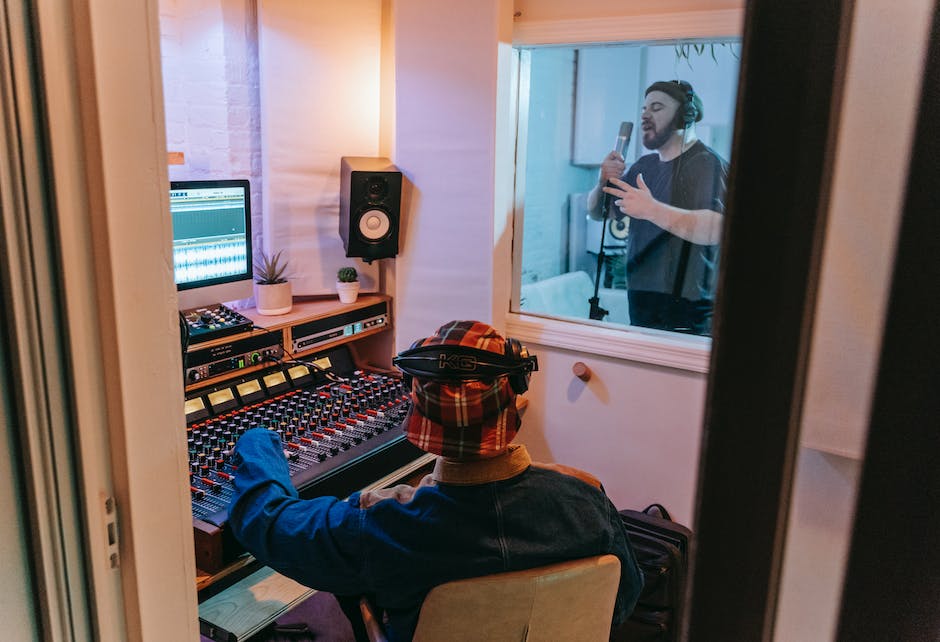
Equipment Essentials
Remarkably, each captivating song we listen to on our favorite streaming platform, each riveting performance we encounter at a music festival, is the result of much strenuous work behind the scenes. Central to that hidden bedrock are certain recording tools which are the golden tickets, the must-haves in any audio engineer’s bag. They serve as the architects in constructing a splendid soundstage receptive to stirring performances.
Undoubtedly, a powerful microphone strikes prominently on the list for managing audio challenges in live settings. Microphones of varied types and capacities are built specifically for different sound sources. When one aims to amplify instruments on a boisterously energetic stage, directional microphones are crucial for achieving the desired effect. From floating crystal clear vocals above a roaring crowd to capturing the rhythmic intensity of a drum kit, directional mics have the providential aptitude to selectively capture sounds while maintaining their original robustness.
Equally precious, a high-quality digital audio workstation (DAW) stands as the veritable cornerstone of any live audio recording setup. DAWs, like Ableton or Pro Tools, allow for real-time editing, effect implementation, and sound mixing, thereby becoming an imperative tool in the management of audio challenges on stage. Furthermore, they allow for swift improvisational changes, a dear feature in an environment as dynamic as a live concert.
Next, let’s tune our focus to an often overlooked audio tool: the headphone monitor. Essential for performers and sound engineers alike, headphone monitors enable a perceptive ear on the ever-vital mix while offering an unobtrusive performance. This invaluable tool enables performers to retain audibility of their performance, even amid the insurmountable raucousness of a live audience.
The portable audio recorder is also worthy of note. Notably discreet and resourceful, these compact devices have become a treasure for live audio recording. They possess the prowess to capably handle high sound pressure levels while offering a high degree of convenience, essential in the spontaneous ambiance of live performances.
Last but not least, a robust and reliable PA system is a prerequisite for any live setting. Capable of providing sterling sound quality to all corners of an immense venue, a PA system serves as the steadfast bridge connecting artists to their audience. An immersive audio experience is critical in a live setting, differentiating it from the experience of merely streaming your favorite artist at home.
As discerning lovers and creators of music, we naturally cherish the power and depth of live performances. The highlighted recording tools, refined over decades, have indubitably revolutionized our capability to accurately capture and reproduce the raw magic of live music. The secret to managing audio challenges in a live setting, consequently, lies in an articulate understanding and masterful implementation of these essential pieces of equipment.
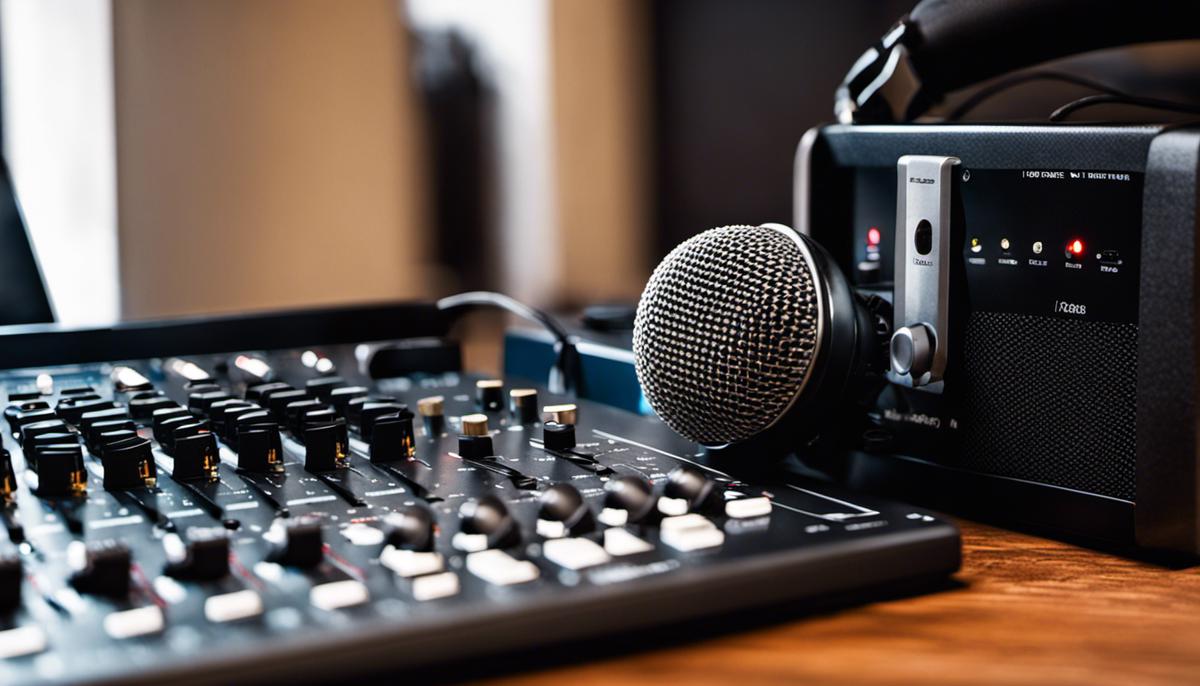
Techniques for Quality Recording
A symphony of sound—rich, raw, and rhythmic—rehearsals truly are the brewing pots of musical magic. They offer a candid view into the heart and soul of any band, revealing their essence and embodying their vigor. However, to capture this spellbinding energy in an audio recording is no less than a craft. A craft that involves several elements beyond a mere ensemble of high-tech gadgets.
Vital and often overlooked, a meticulous song structure forms the bedrock of any successful recording. Draft a guide track with the fundamental rhythm and tempo, ensuring everyone is harmoniously synchronized. This not only enhances the overall cohesion, but also helps in precisely adding or modifying individual parts later. Just like the simpatico amongst band members, the relationship between instruments is integral.
While hovering through rehearsals, remember to encapsulate the magic of room acoustics. A captivating element of “in the room” recordings, it reflects the ambience, the vibe, the serenade. Experiment with different rooms and pay attention to the sonic properties of the space—the size, the materials used in construction, the presence of furnishings, or even the air density. Whether it’s the echoey reverberation in a Cathedral or the intimate quietude of a home studio, it can impart an undeniable flare to any recording.
Further amplifying the allure of room acoustics is the configuration and positioning of microphones. Consider a beaming sunflower—an array of microphones intricately arranged, each bent towards the fragrance of sound they wish to capture. Utilize omnidirectional mics for a wholesome depth or go for the characterful individualities of directional mics. Experiment, explore, and embrace the wonders these technicolor transducers can yield.
Often, it’s the dominance of live amplifiers that leave murmurs of instruments lost in the melodious crowd. To prevent this tragedy of drowned symphonies, a direct input (DI) box can serve as a lifeline. It preserves the unique character of instruments, giving each its own pedestal of glory. The purity of acoustic guitars, the subtleties of keyboards, or the earthy tones of bass— a DI box ensures they all resonate in harmony, not anonymity.
Last, but not least, an often underestimated hero in this pursuit is the sound of silence. Decoding the dialect of pauses and breaks can offer an adrenaline rush, as potent as a soaring guitar solo or a hefty drum fill. Allow some breathing space in the recording, facilitating a wholesome and immersive experience. The silence between notes, the pause before a crescendo, the calm after a storm— each contributes to the tale each track tells.
Immersing oneself in the splendiferous world of music making and recording is an intoxicating journey. And to embrace these dynamic aspects to ensure high-quality band rehearsal recordings is to truly connect with the soul of music. A love letter to sonic creativity, it’s a testament to the beautiful chaos, the harmonious discord, and the rhythm in randomness that music truly is. Shed inhibitions, delve into obscurities, and navigate through the enchanting realms of sound. After all, isn’t that where the true magic lies?
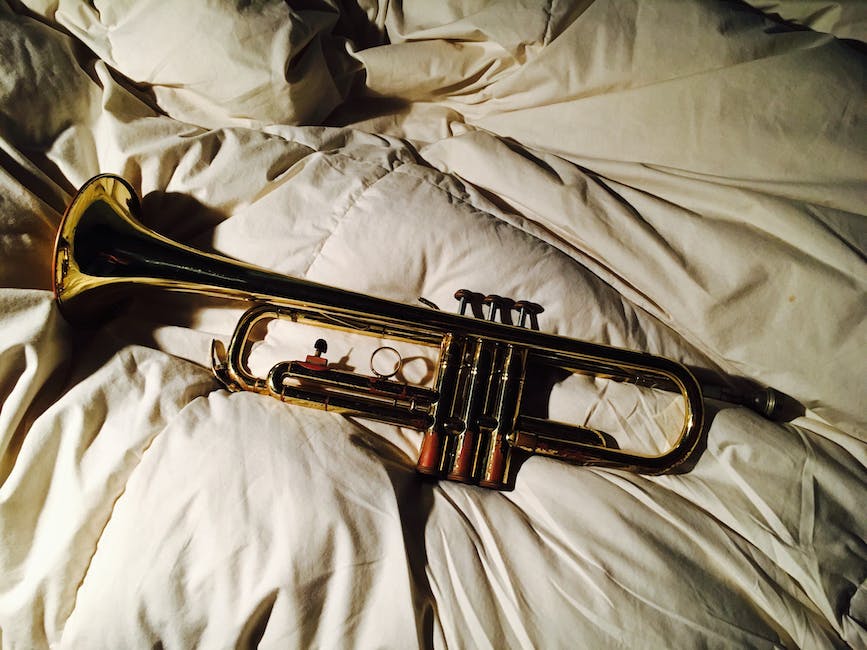
Post-Recording Cleanup
Beyond the flair of on-spot creativity that live band rehearsals proffer, there are always bound to be minor glitches. It’s the beauty and risk of the ‘live’ element. Slips, knocks, slides, albeit their raw charm, can often be distracting when it transcends the rehearsal space. This is where the grace of post-recording cleanup comes to play. It helps refine the captured audio, ensuring the vibrancy of the live session is neither lost nor marred by inadvertent flukes.
In the world of music, the interplay of every note, rhythm, and pulse reveals an emotional tapestry that connects to the audience. Unwanted noises and lingual slips can disrupt this musical story, disrupting the listener’s journey. Post-recording cleanup serves as a warranty for your captured audio, preserving the integrity of the song while ensuring small errors are carefully scrubbed away.
Echoes, feedback, and distortion – all enemies of a pristine recording – are unavoidable in a rehearsal space. This is where the magic of audio processing tools comes in. Equalization (EQ) can be employed to help sculpt the tonal balance, removing inevitable stubborn echoes. Tools like compressors and limiters help control variations in volume, taming the potentially disruptive dynamics that can arise in a live band rehearsal.
The ambience of the room, whether intentional or just a byproduct of the location, can add a touch of authenticity to your sound. However, too much echo or reverb can confuse the listener and conceal the clarity of individual instruments. Delicate applications of de-verb and spatial plugins can rein in any surplus environmental noise, returning emphasis back to the music.
Moreover, to honor each string’s strum, every drum’s beat, and let shine the distinct timbre of every voice, spectral repair tools can offer miraculous solutions. They provide us with a mechanism to isolate and mend unwanted noises on a detailed level without debasing the overall aesthetic of the recording.
In the end, cleaning up a live rehearsal recording isn’t about sterilizing it to the point of sterility. It’s about unmarred communication between the performer and the listener, allowing the raw, electric energy of the-band-in-the-room to come through without distraction.
By investing the time and resources into post-recording cleanups, the inventive roughs of the musical world are refined into glorious, resonant gems. Fusing the livewire spontaneity of live rehearsal with the delicate touch of modern audio cleanup techniques births an audio that’s honest and vibrant, yet professionally accomplished. It’s the vivid, emotional invite into the musicians’ world, every calculated beat, unbridled energy, and captivating harmony delivered in the highest fidelity. That’s the sweet symphony of refined live band rehearsal recordings. It’s not just music—it’s alive.

As we conclude this deep-dive exploration, it is evident that recording band rehearsals in a live setting is indeed an art. It is an intricate play of understanding various challenges, effectively using recording equipment, applying diverse techniques, and finally grooming the track in post-production. The journey may seem daunting at first, but armed with the right knowledge and a passion for music, an enthusiast can navigate their way towards a stellar recording experience. Regardless of the challenges that are inevitable in a live recording situation, the resulting piece of music, brimming with unedited creativity and energy, makes all hurdles worthwhile.
Music – a language that knows no boundaries, remains incomplete without the assistive brilliance of technology. One such gem in the music world’s crown is ‘phantom power’ that amplifies the harmonious symphony of sound from condenser microphones. This essay delves deep into the realm of phantom power, offering the readers a lucid understanding of its functioning, applications, and significance. Apart from demystifying complexities, it also attempts to tackle common hitches that one might stumble upon while using phantom power in connection with condenser microphones. As artists constantly strive for perfection, the essay delivers unique insights on best practices, empowering them to transform every musical endeavor into an exemplary performance. Lastly, recognizing that music is as much about its past as its future, the narrative traces the evolutionary journey of phantom power itself, from its humble roots to its present day ubiquity in the music industry.
Understanding Phantom Power
The Symphony of Silence – Unraveling the Mystic Melody of Phantom Power in Condenser Microphones
In the symphony of sound that dances around our ravaged eardrums with the elegance of a thousand ballerinas, there exists a deep, silent whisper. A whisper so entwined in the very essence of sonic expressions that its absence resounds as loudly as its presence – the mystical melody of phantom power. It lurks within the shadows, whispering life into metallic lungs. It thrives in the unseen corners of stages and studios, one of music’s unsung heroes, much like the humble condenser microphone.
To understand the significance of phantom power, one must first appreciate the exquisite artistry of the condenser microphone. A creation so infinitely mysterious, that it breathes life into waves of air, converting audible art into energetic impulses. But this magical mic is far from a simple spectator to the grand concert of melody and rhythm. It yearns to take center stage, plugged into the orchestra of electronics, consoling the frenzied storms of symphonies into tantalizing whispers.
Without a generous swig of phantom power, the very heartbeat of the condenser microphone would flatline, its voice imperceptible. This is where the thrilling symphony of sound and science fuses into thundering crescendos and hushed lulls. Phantom power is the invisible conductor orchestrating this grand performance, the very string that plucks at the heartstrings of a condenser microphone.
Akin to a choir member’s nod to the maestro, the condenser microphone recognizes phantom power as an invitation to perform. Without this ethereal energy relayed through microphone cables, the condenser microphone remains locked in a silent standoff with sound. This power, largely in the 48-volt range, sneaks through the XLR cable, telling the microphone to awaken from its slumber and sing in harmony with the symphony of sounds around it.
Simply put, the condenser microphone is a perfect example of a sonorous symphony’s quiet protagonist. It carries the heavy weight of capturing the music world’s unspoken whispers and guttural growls. Without its backstage hero – phantom power- there can be no triumph over the cacophony of silence.
Existing in the shadows of stages, phantom power embraces its ethereal name rather fittingly. Its invisibility in the sonic sphere belies its significance. Ever so subtly, it energizes the condenser microphone, making it an integral part of recording studios’ tapestry and colossal concert fields.
As passion-seekers in the all-consuming embrace of sound, we must pay our dues to this ninja of the sound world. In the hushed whispers of phantom power, we find the silent protagonist, breathing life into every note and rhythm. A perfect potion to soothe and awaken the metallic lungs of the condenser microphone, making this intelligent design of human innovation hum along the harmonious milestones of music.
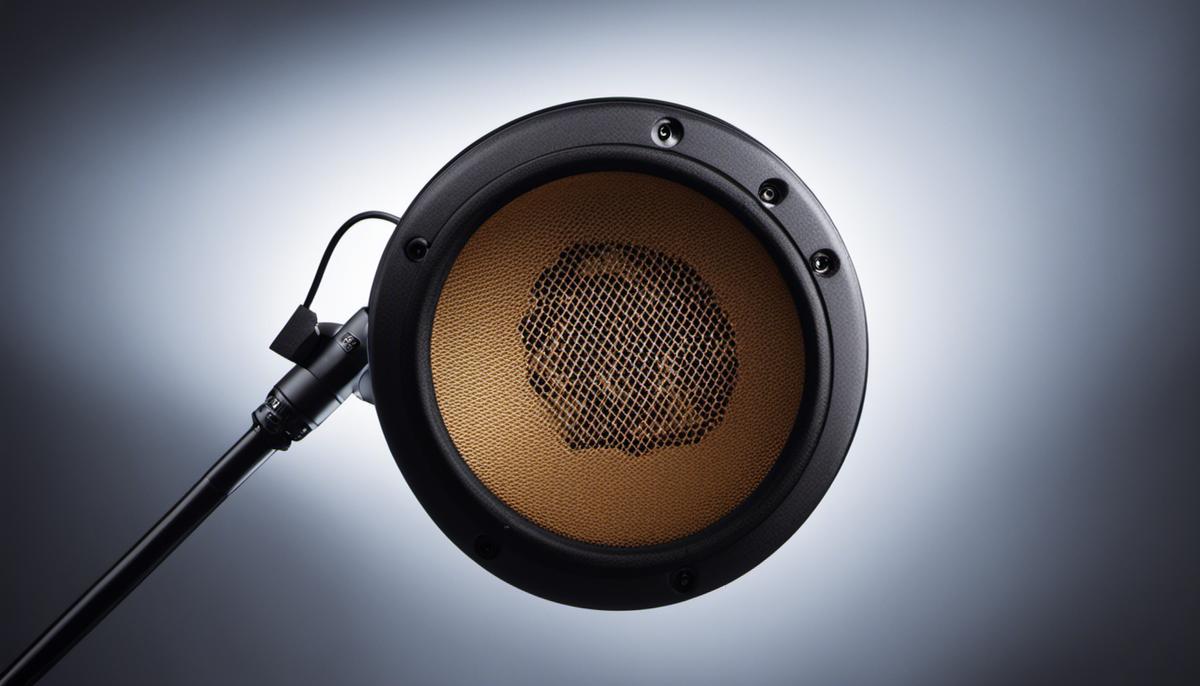
Phantom Power Troubleshooting
The almighty force known as phantom power, crucial as it is to the successful operation of condenser microphones, is not without its potential complications and predicaments. There are common pitfalls and challenges that can filter into the world of sound and disrupt the symphony. It’s necessary to acknowledge these issues – and, more importantly, understand how to address them – to maintain harmony in the realms of music creation and appreciation.
Just as a finely tuned violin or a meticulously crafted guitar can suffer from string clashes or fret buzz, the delicate balance of a condenser microphone setup can also veer off-course. One of the most common phantom power snags is the dreaded possibility of inconsistent voltage. If the ideal voltage of 48V dips or fluctuates, the quality of sound captured by the condenser microphone can become distorted or degraded. This problem could emerge from a myriad of sources, including a deficient preamplifier, inadequate cables, or even an unstable power supply. The solution rests in careful troubleshooting and equipment testing to identify the weak link and restore the power pathway.
Yet another ghoul that can haunt phantom power is an audible hum or buzz, piercing the ether of music with its unsettling presence. This unwelcome addition to your sonic space is typically caused by a grounding issue. It’s often the consequence of an imbalanced impedance match between the microphone and the recording device. To exorcise this sonic specter, you might need to consult your gear’s manual to ensure proper impedance matching or tweak your grounding practices.
The nightmare scenario of phantom power shorting out is also a reality that must be addressed. A short circuit, possibly due to a miswired microphone cable, can cause your power supply to fail. This potentially catastrophic event underscores the significance of proper maintenance and careful handling of your cables. Regular cable checks and necessary replacements will keep the vivacious heartbeat of your music thriving.
Let’s not overlook the interference caused by radio frequency or RF. Though not specific to phantom-powered setups, RF interference can cause apparent phantom power problems. Faulty cables and poor shielding can act as antennae, picking up unwanted radio signals. Using a balanced cable system and ensuring that any nearby wireless devices are operating at different frequencies can help ameliorate this problem.
Though these phantom power setbacks might appear formidable, they’re typically more akin to a discordant note in a symphony than a halted performance. Just as every musician discerns the subtle layers of rhythmic pulse and melodic ebb and flow, the vigilant troubleshooter, too, can identify and resolve these phantom power predicaments. The dance between problem and solution, hardship and triumph, is another intriguing composition in the grand symphony of sound, an ode to the ever-evolving love affair we have with music.
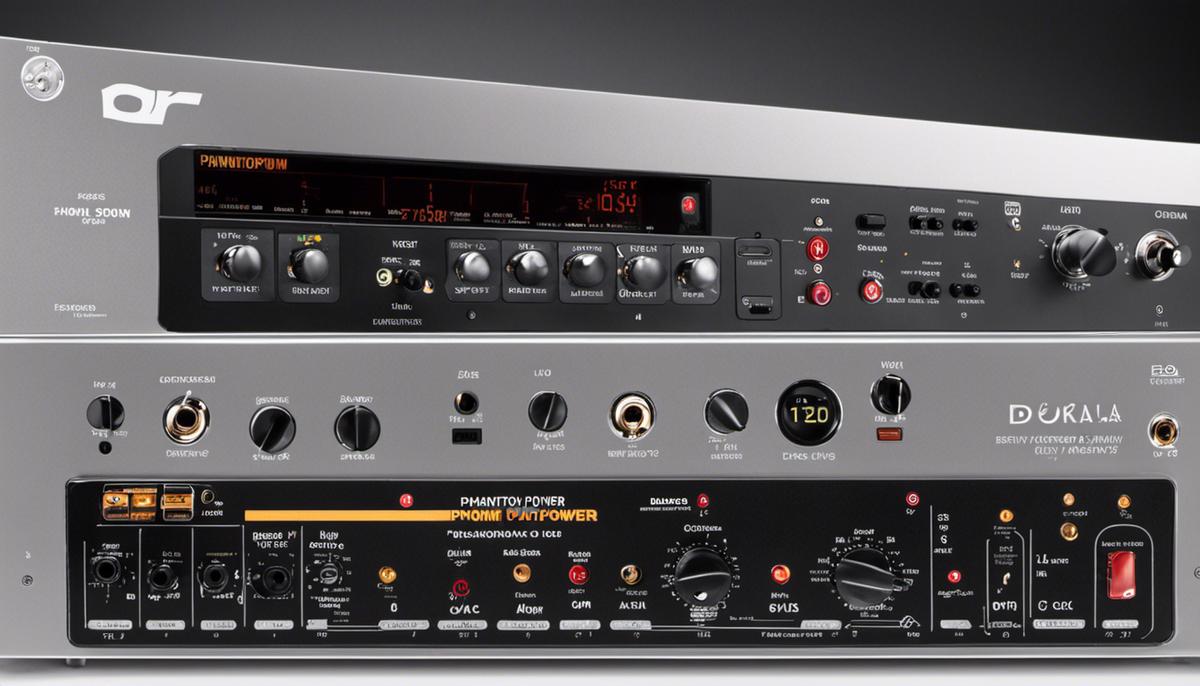
Best Practices for Phantom Power and Condenser Microphones
Ready to dive deeper into the captivating world of music where every whispered note, every subtle timbre is a testament to the unseen power of technology? Luckily, having already explored the concept of phantom power, and the pivotal role it plays, it’s time now to delve into the nitty-gritty of optimizing its use for an unrivaled musical experience.
Music, a concoction of passion, talent, and technology, invites individuals both on the stage and in the studio to understand its complexities. Among these is phantom power, a seemingly invisible entity, which, when categorized by voltage inconsistencies, can weave a chaotic symphony of obstacles.
Voltage inconsistencies can distort and degrade the audio quality, transforming a blissful melody into disjointed notes. Challenging? Yes. But fear not – overcoming these inconsistencies often lie in choosing high-quality power supplies and thoughtfully constructed audio interfaces. Ensuring the power supplied to the condenser microphones is stable and consistent can make all the difference in a recording or live performance.
But there’s more than just voltage issues to be mindful of. The technical elements of sound engineering are like a tightly woven symphony, each instrument contributing to the whole. Imagine, in that symphony, a rogue instrument: the hum or buzz caused by grounding issues, an audio arch-nemesis capable of injecting a jarring note, a discordant tone into the enveloping music.
Grounding issues usually stem from an unbalanced electrical load or improper equipment setup. Just like a maestro leading the orchestra, rectifying each grounding issue comes down to meticulous inspection and adjusted settings. It’s about mastering control over the elements which, while hidden within the depths of cables and interfaces, have significant implications on audible output.
As musicians, sound engineers, or even ardent music lovers, short-circuiting and power supply failures can seem like a nightmare set to an unfortunate soundtrack of silence. But remember, even a glitch can become a part of the rhythm in the grand dance of music making. Post such scenarios, vigilance and preventive care rise to paramount importance. This comes in form of investing in reliable power units, extending regular check-ups to the entire gear, and ensuring the protective measures are taken during storage or transportation.
Speaking of transportation, attention must also be paid to a ubiquitous yet overlooked source of disturbance – radio frequency interference (RF). Any recording studio or concert field can be awash with waves from nearby electronic devices, creating an unwelcome distortion in the otherwise pristine notes.
The key to dancing around this issue lies in the balancing act of cable systems and smart handling of wireless devices. Balanced cables are robust, reducing susceptibility to RF, and when paired with meticulous device management, can significantly limit the risk of interference.
From troubleshooting phantom power issues to maintaining and handling cables with care, sound production asks for the meticulous effort akin to composing a melody. Every cord, microphones, and power source has a part to play in this magnificent composition of sound. This tale of unending dedication is a testament to the continuous love affair with music and its challenges.
Finally, let it be said that the pursuit of superior sound quality is not without its hurdles. But it’s in meeting these challenges head-on, in appreciating the essential, albeit silent role of something as mundane as phantom power, do we truly tune into the magical symphony that music truly is. And isn’t that, after all, the crux of any outstanding musical experience?

Evolution of Phantom Power in Condenser Microphones
Evolution is the lifeblood of music, unceasing in its primal heartbeat, constantly shifting, reforming, and metamorphosing in its endless strive for innovation. Paralleling this ceaseless transformation, the advancement of phantom power in condenser microphones has been instrumental in the journey of sound. The narrative of phantom power evolution, though often shielded behind curtains of obscurity, radiates through the concert fields and recording studios, catapulting music into the realms of sonic grandeur.
By breaching the confines of the mechanical transducer world, phantom power flickered to life in this sonic universe sometime in the mid-20th century. Pioneering a revolution, it brought an increased recording flexibility to condenser microphones, thus enhancing the dynamism of music production. The newfound ability to operate without bulky external power boxes was indeed a watershed moment in live performances and studio recordings, forever altering the mobility and responsiveness of the production process.
Yet, like any construct in the whirlpool of technological evolution, phantom power has been subject to steady stages of metamorphosis. Over the years, the standard voltage of phantom power has heightened from a meager 12V to an efficacious 48V. This escalation, though seemingly minute, has monumental implications. The raised voltage allows condenser microphones to capture a broader frequency response and superior transient performance, creating a more defined, undisrupted connection between the artist and the listener.
These evolving standards of phantom power have also enabled a greater range of tonal possibilities, catering to diverse music genres. Rock bands, symphony orchestras, jazz trios, all are beneficiaries of this evolution. The spectrum of sound has been widened, propelling us further into the sonic ecstasy of music.
But the journey was not always gleaming with improvements. The turbulence of radio frequency interference initially posed detrimental threats, often warping the purity of sound with annoying hums and buzzes. However, advancements in technology led to the incorporation of Radio Frequency Interference (RFI) filters into mic preamps, restoring the sanctity of the sonic realm and exempting audiences from the dreaded disturbance.
The evolution of phantom power in condenser microphones is a testament to the relentless pursuit of audio perfection, a quest unyielding in the face of hardships. It’s a symphony in itself, studded with high notes of triumph, and soulful interludes of tribulations. It’s reflective of the beautiful, maddening, and joyous quest for harmony that unites everyone in the music fraternity. It sings of an industry fervently committed to delivering the composers’ visions and the artist’s emotions, all under the unseen halo of phantom power.
As we twirl to the beats of the modern music world, may we continue to embrace the subtle symphony of phantom power. The journey may not be visible to our eyes, but it breathes life into our ears every day, one track at a time, filling the world with the spirit-ruffling, heart-thumping symphony we call music.
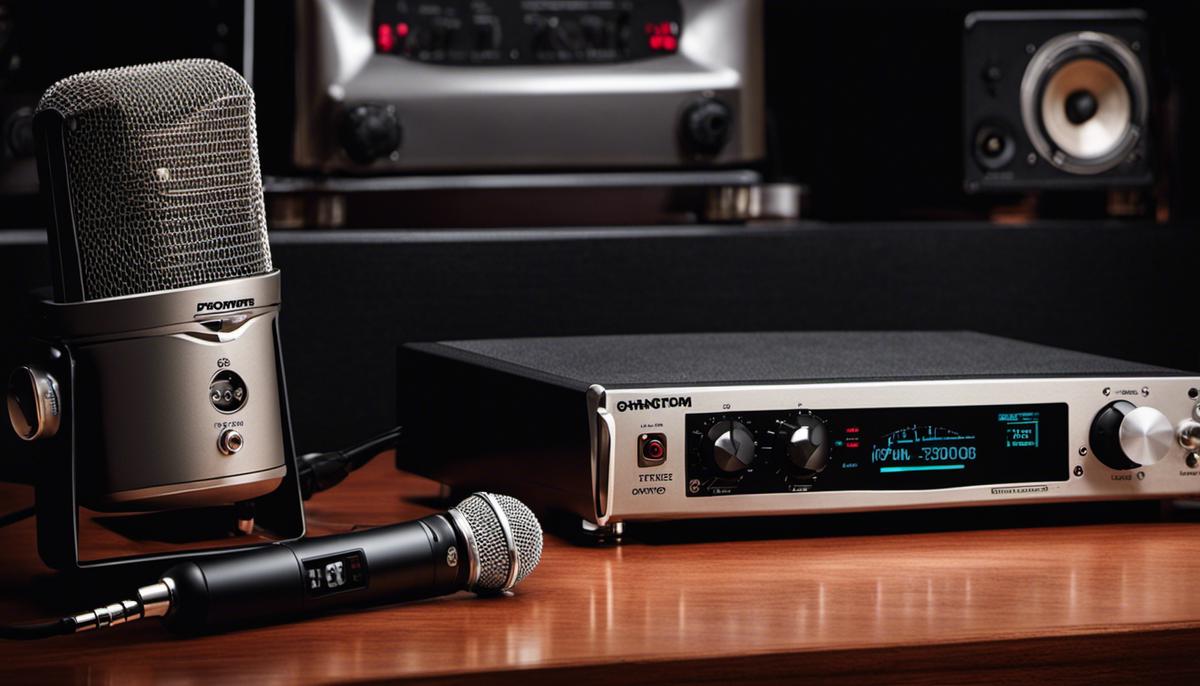
Powering through the crescendos and decrescendos of the music industry, the ever-present phantom power has shaped the way we create and perceive music today. The unseen conductors of the grand symphony, phantom power and condenser microphones are significant pillars upholding the auditorium of sound. Regular troubleshooting and adherence to best practices ensure that this powerful tool remains consistent in producing pristine audio. In retrospect, the evolution of phantom power in condenser microphones proves that music technology only matures with time, fostering a fresh resonance for every epoch. As the magical carpet of phantom power unfurls, it continues to aid passionate musicians in etching their melody into the heartbeats of music lovers, from past to the future.
There’s a unique craftsmanship to playing the drums, one that becomes even more refined when embracing the detailed nuances of drum miking and tuning. Irrespective of the drum set or style, an array of technicalities comes into play, defining the sound produced instantly and substantially. Familiarizing ourselves with these aspects, specifically the art of drum miking and tuning, is an essential journey for every drum enthusiast. The process of understanding microphone types, nailing down the perfect placement, and assimilating the dynamics of pitch increment tuning invokes the virtuoso in us, paving the path for a more resonant drumming experience. Add to this fact, the ability to troubleshoot common hurdles can transform a good sound into an excellent one.
Understanding the Basics of Drum Miking
Upon the symphony of sounds emanating from a live music stage, the propulsive energy of the drums often holds court.
The heartbeat of any ensemble, the drum kit, creates a tapestry of rhythmic and acoustic filigrees that any music aficionado can truly appreciate.
As such, drum miking – the art of capturing that rhythmic heartbeat – shouldn’t be perceived as an ancillary part of the music-making process.
Instead, let’s marvel at this process as an essential rhythm-attuning symphony of its own.
Here we delve into the core principles of drum miking, perhaps taking you closer than ever before to the resonant, soul-stirring boom of live drum music.
1. Endeavor for Balance:
Drum miking is as much about principles as it is about passion.
And balance, like a symphony’s conductor, reigns supreme in this regard.
A well-miked drum set ensures balanced sound between all constituent elements – the snare, kick, toms, hi-hat, and cymbals.
Each component should be heard clearly without overwhelming the others.
Striking that perfect harmony between all pieces is vital to achieving that well-rounded, full-bodied drum sound.
2. Explore Angles and Positions:
Each drum and cymbal has a unique sound, and their positions relative to the microphones can drastically affect that output.
The art lies in figuring out the best angles and positions for each mic.
For instance, a kick drum will have a more punchy sound when the mic is placed inside the drum, while a snare drum needs the mic to be tactfully positioned above the rim.
Proximity and angle experimentation with the mic can significantly impact the tonal quality, opening up a universe of soundscapes.
3. Usage of Appropriate Microphones:
Not all microphones are created equally.
Different drums require different microphones, each catering to the nuances of the respective drum’s tonality.
Large-diaphragm dynamic mics are typically used for kick drums due to their lower frequency response.
On the flip side, the snare drum and toms usually work well with small-diaphragm dynamic mics, which handle the high SPL and offer a broad frequency response.
4. Consider Room Acoustics:
The quality of drum miking isn’t solely determined by the drum kit and microphones.
Room acoustics play a crucial role too.
The sound produced by the drum kit will interact with the room, creating unique vibes that can enhance or mar the final output.
For optimal acoustics, the room shouldn’t be too reverberant, which can make the sound muddy, nor too dampened, which can make it feel lifeless.
5. Phasing Matters:
The phase relationship between all mics can significantly affect the final drum sound.
When miking a drum set, remember that the sound from each drum will reach each microphone at different times, leading to phase cancellation if not managed correctly.
Using a phase switch on the microphone or within the audio software can help rectify this.
6. Mic For The Audience, Not The Drummer:
When positioning mics, it’s important to consider the audience’s perspective.
While it’s critical to capture the drummer’s dynamism, the end goal should always cater to the listeners’ experience.
Drum miking is more than a mere technical exercise, it is a rhythm-centric poetry in motion.
As free-spirited as the artist bang-banging those drumsticks, these core principles serve as gentle guideposts in your auditory journey.
Now, take the plunge: capture the pulse, make the drums speak, and mold music in your image.
Remember, there’s no ‘right’ way, only ‘your’ way to this rhythmical symphony! Happy drum miking!
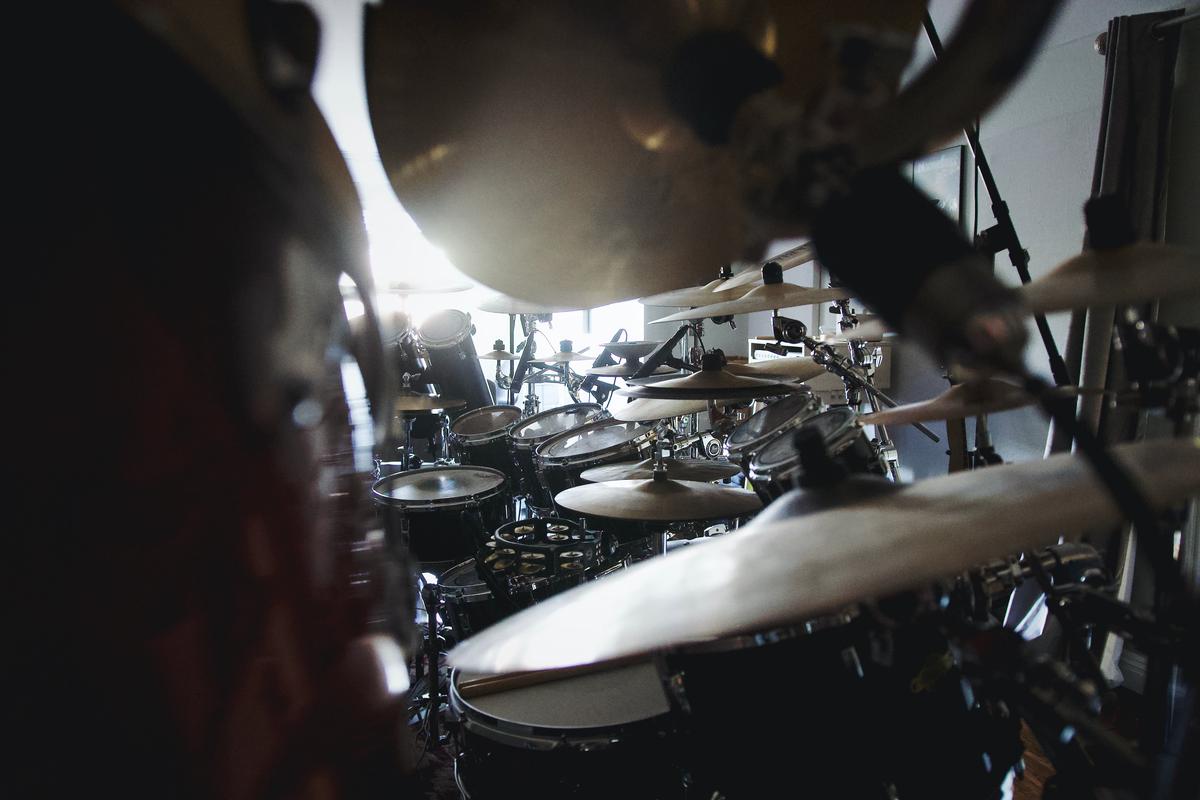
Photo by minimdesignco on Unsplash
Drum Tuning Techniques
Reverberating Rhythms: Navigating the Nexus of Drum Tuning
Within the compelling mosaic of music creation, the distinct timbre of a drum can spell the difference between a mere beat and a resonant rhythm that sparks soul-stirring emotions. Beyond the precise positioning of microphones and the meticulous consideration of room acoustics, the art of drum tuning is a crucial cog in the machinery of music production. This complex process impacts the overall sound quality, unfurling a sonic tapestry of tones and textures that evoke a sensory feast.
Drum tuning is not just a matter of adjusting tension for readiness; it’s a finely honed craft that imbues the drummer’s beat with unparalleled dynamism, molding soundscapes with every strike and stroke. Varied tuning methods serve as conduits for a diverse palette of sonorous storytelling and can paint aural portraits that traverse the spectrum of genres.
Firstly, pitch tuning shapes the tonal quality of drums in a pervasive manner. A drum with a higher tuning sings with a clear, resonant tone, evoking a sense of urgency and energy. Conversely, lower tuning resonates with a deep, mellow, and ambient vibe – a pulse that forms the backbone of softer, introspective musical journeys.
Moreover, musicality greatly depends on interval tuning or tuning the drum kit to specific intervals. This creates a separate pitch for each drum, allowing a fluid melodic flow that dances harmoniously with the other instruments. Deft manipulation of these intervals can weave intricate harmonies that make a song feel like an intimate conversation between its instrumental counterparts.
Another significant method revolves around edge tuning. Tailoring the edge pitches to resonate perfectly with the drum’s central pitch can cultivate a thrilling consistency of tone. This technique yields a pure, unbroken sound that seems to reverberate from the core of the drum – a vibrant echo expanding outward in a bold declaration of sonic identity.
Furthermore, utilizing overtone tuning optimizes the drum sound by taming the unwieldly overtones. Rather than dampening these tenacious ringings fully, you can skillfully tune and integrate them into your desired acoustics. Doing so enables you to imbue your piece with a rich complexity that elevates your music beyond the boundaries of simplicity.
Delving deeper, head-to-head tuning—equal tuning of both heads—produces a full-bodied tone with a lengthy sustain. Alternatively, tuning the batter head lower than the resonant head generates a punchy, focused beat akin to the heart-thumping calling of war drums. Conversely, if the batter head is tuned higher than the resonant head, you get a sharp, crisp note layered with the essence of riveting drama.
The metamorphic power of drum tuning can transform the drum from a rhythm keeper to a heartbeat manipulator. Which method ignites your musical flame is a matter of personal preference, but the exploration of these pathways is a quest worth embarking upon.
Dive deep into the world of drum tuning, and in every beat, you will sense the palette of musical colors that rings within. Be it a crystal-clear high pitch, a deep ambient melodious pulse or a well-managed overtone – each tuning method is instrumental in carving the soulful silhouette of your song in the listener’s mind. Embrace the power of sound manipulation and enthrall your audience with a symphony of feelings. Allow the finely-tuned rhythms to reverberate through them, sparking their imagination and igniting their passion for music.
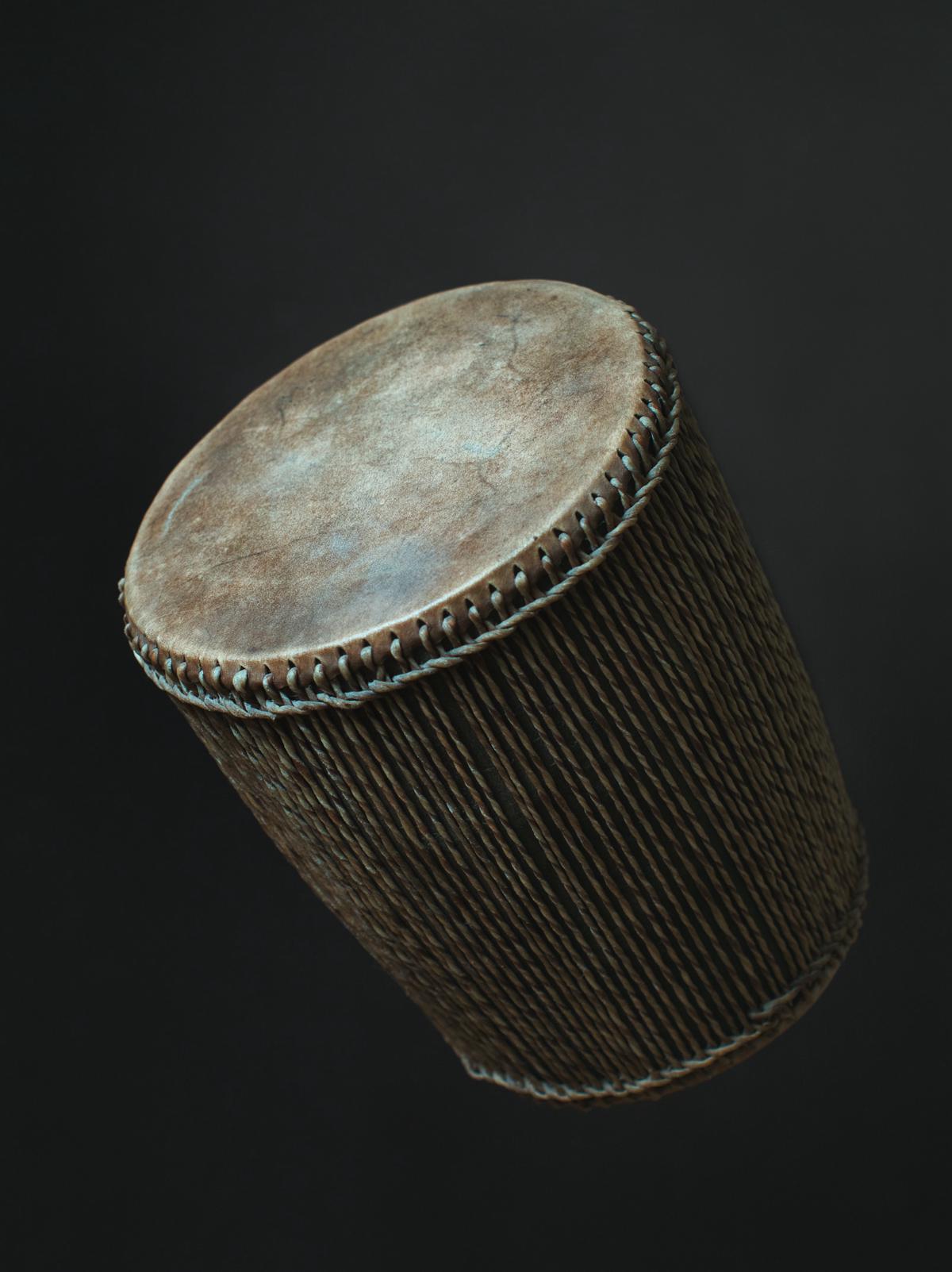
Photo by lukasz_rawa on Unsplash
Troubleshooting Drum Miking and Tuning Problems
Once balance and microphone positioning are established, many aspiring musicians hit a wall when it comes to drum tuning and miking. Each drum beat is a pulse running through the veins of a song, resonating within the listener. However, without careful attention to tuning and miking, the drum’s spirit can be lost or distorted, causing a ripple effect through the entirety of the musical piece. With that said, let’s dig into some common drum miking and tuning problems and their remedies.
A prevalent challenge in drum miking involves the overemphasis of certain frequencies. This issue often arises due to the proximity effect – a phenomenon in which low frequencies get boosted as the microphone is placed closer to the source. The effect can lead to an overwhelming bass which drowns out other finer details of the drum’s timbre. To tackle this, take a step back and move the microphone away from the drum. This will allow the frequencies to breathe, and maintain a composed and balanced resonance.
Another frequent mishap comes not from the drum itself, but from the surrounding environment. Ambient noise can be a pesky interloper, creeping into your recording and marring the purity of your drum sound. To rectify this, the use of a high-pass filter can be a game-changer. This tool helps filter out lower frequency noise, allowing only the drum sound to pass through uninhibited.
In terms of tuning, a common pitfall is inconsistent tension across the drumhead, resulting in an unstable pitch. This issue often roots in the uneven tightening of tension rods. An effective solution to this problem is the use of a drum dial, a tool designed to measure the tension of the drum skin. By keeping a close eye on this device while adjusting the tension rods, the drummer can ensure equal pressure across the drumhead. This way, the drum sound remains stable and true throughout the playing session.
The odd ringing sound, often known as ‘overtones,’ can be another hurdle in achieving the perfect drum sound. These extraneous sounds can be tamed through dampening techniques. Subtle application of tape, moongel or even a bandana on the drumhead can dampen these unwanted frequencies, allowing the clean, core sound of the drum to shine through.
To conclude, the mastery of drum miking and tuning is an art in its own right. It presents an exciting challenge, a puzzle waiting to be solved. Yet, with patience, exploration and a keen ear, any drummer can embark on this journey, overcoming these common obstacles. In doing so, they allow the drum to truly beat in harmony with the song, captivating the listener and embodying the essence of the rhythm. After all, every pulsating beat of the drum is a heartbeat in the living entity that is music.
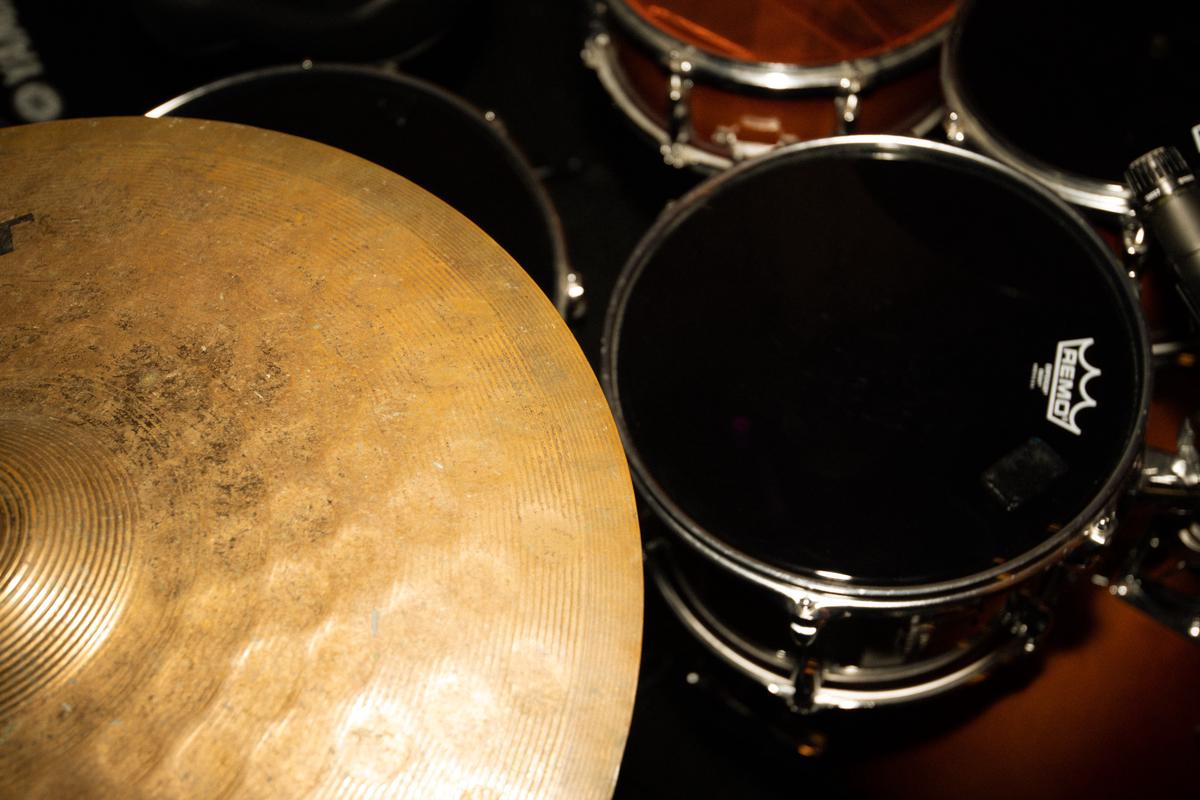
Photo by mattmoloney on Unsplash
With knowledge comes mastery, and in drumming, an understanding of the technicalities can make a world of difference. As we embrace the vibrant dynamics of drum miking and tuning, we adopt a more nuanced approach to creating music. Taking the time to understand each component–from microphone types to pitch increment tuning–is an investment in the quality of our sound. Improving these skills not only enhances our playing but sharpens our ability to troubleshoot potential issues. The world beckons the notes we play, and knowing the ins and outs of drum miking and tuning helps us resonate loudly and clearly.
The world of music production entails various aspects and techniques that resonate with the harmony of acoustics, main among these being the concepts of Soundstage and Stereo Imaging. These paradigms have a profound effect on a listener’s cognitive connection with the music, forming an aural tapestry that features dimensionality and direction. However, when it comes to mixing on headphones, these paradigms bring forth unique challenges. As much as headphones offer the luxury of mobility, they often distort the perception of stereo field and depth, resulting in mixes that fall short in other settings. This article delves deep into the challenges associated with Soundstage and Stereo Imaging while mixing on headphones, presenting practical techniques to overcome such hurdles, and emphasizing the importance of proper tools and sound listening practices.
Understanding Soundstage and Stereo Imaging
The Illuminating World of Soundstage and Stereo Imaging: A Symphony for the Ears
Sweep your mind to a powerful live concert experience. Imagine the electrifying charge of the guitar resonating from the stage right, the thunderous heartbeat of the bass drums streaming from stage left. Each instrument and vocalist command their unique space on the stage, harmonizing yet retaining their distinctive character. This, dear music connoisseurs, is the magic of astute soundstage and stereo imaging – the essence that brings recorded music to life.
To commence this exploration into music’s invisible landscape, allow us to demystify these two terms. Soundstage is the audio illusion of a three-dimensional space. It is the perception of depth, height, and width in music, the soundscape where each sound source is positioned. On the other hand, stereo imaging refers to the placement of these individual sounds within the soundstage, building a vivid, musical picture for the listener.
But why, pray, do these elements hold such quintessential value in the craft of mixing music? The allure of soundstage and stereo imaging lies in their capacity to generate an immersive, engaging listening experience that transcends the boundaries of mere consumption into the realm of participation. It’s a feast for the ears as they banquet on a buffet of sounds spread across a 3D stage.
With a robust soundstage and precise stereo imaging, music evolves from being a flat, one-dimensional stream into a topographical landscape filled with nuances and crevices. The majesty of a violin can float majestically from the right while the poignant serenade of a piano wafts in from the left. Meanwhile, the tender whisper of the lead vocalist embraces your sensibilities, emanating from the center with uncanny realism.
This spatial awareness not only allows for a richer listening experience but also pays respect to the work of passionate musicians. A sound engineer employing these mixing elements doesn’t merely polish a creation to perfection; they recreate the stirring live experience of music. It encapsulates the raw energy of a live performance, retaining the individuality of each instrumental note, each whispered lyric.
Moreover, proper soundstage and stereo imaging unveil the intricate layers of a piece, the textural beauty that can be camouflaged in an undifferentiated mass of sound. It’s about teasing out each element, letting it shine individually yet play its part in the symphony.
As vital disciples of auditory art, it behooves us to acknowledge that soundstage and stereo imaging are not just technical tools; they are the unseen conductors orchestrating our sensory interaction with music. They carry the power to transform any passive listening experience into an intense musical journey across arenas, shrines, and deserts, all from the luxury of our favorite headphones.
And thus, in this nexus of sound, music transcends into a shared realm of experiences, emotions, and beauty. Assuring that in the world of music, we lose ourselves in the melody, wandering within the realm of audacious harmony and captivating creativity where each note, each beat, each voice finds its rightful place. It is within the hidden depths of soundstage and stereo imaging that each music lover finds their own space to be, to feel, to resonate.
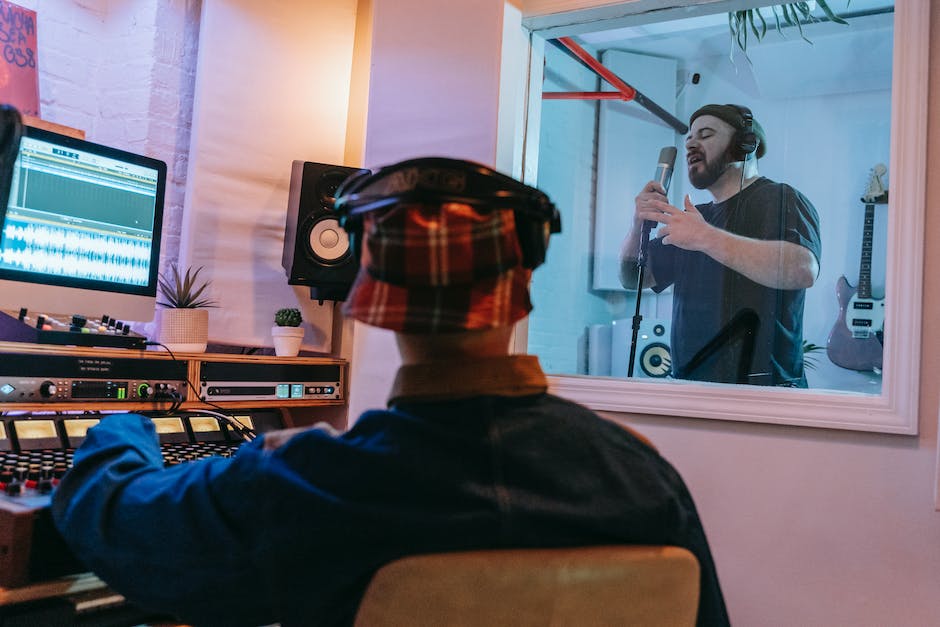
The challenge of Mixing on Headphones
Adventures of the musical kind, our invisible dance partners leading us across bridges of rhythm and melody, are deeply intertwined with concepts like soundstage and stereo imaging. Yet, as we slip on our headphones to rejoin this auditory celebration, we must navigate the challenges these vital elements bring. Particularly, we need to understand what makes mixing music on headphones complicated, particularly with regard to soundstage and stereo imaging.
Foremost among these challenges is how headphones, by their mere design, limit the soundstage. Unlike speakers which shower our entire sensory field with a cocktail of sound waves, headphones narrowly aim their aural arrows right into our ears. While this can create an intensely intimate relationship between listener and music, it often leads to a condensed portrayal of soundstage. Rich landscapes of sound may be reduced to a more restricted panorama, subtly changing the dynamic blueprint of the melody. Our senses, wired to embrace sound in an unconfined environment, could interpret this compressed echo as lacking depth or spatial delineation.
Next, we come across the peculiarities of stereo imaging. In a traditional setting, the stereo image is served on an aural silver platter, where the positioning of different sounds across the left-to-right spectrum can be distinctly perceived. However, the delineation of this psychoacoustic phenomenon becomes more challenging when using headphones. Live music breathes in the free air, bouncing off walls and creating complex wave interactions. When confined to headphones, these acoustic idiosyncrasies are squeezed into a channel flowing directly into our auditory pathways, altering the musical experience significantly.
The inability to accurately perceive sonic location within the stereo image can because of the absence of a “crossfeed” effect in headphones. In a live setting or with speakers, each ear perceives sound from both channels with a slight time delay, providing a sense of space and location. This physical phenomenon isn’t naturally present in headphone listening. While some advanced headphones and digital processing artificially introduce crossfeed to emulate this, they may grapple with finding the right balance, further complicating the mixing journey.
Finally, the element of the individual’s perception of music plays a significant role. When traversing the sonorous landscapes painted by soundstage and stereo imaging through headphones, our own auditory sensitivities, preferences, and interpretations sharply come into focus. This might mean that what excels on headphones for one, might lead to a less satisfactory experience for another. Our familiarity with live music experiences also sets a higher bar for headphone-based mixing, making the task an intriguing mixture of science and unceasing creativity.
Mixing music on headphones, while challenging, is not a futile exercise in sonic acrobatics. Rather, it’s an avenue for exploration, a call to innovate and adapt. Precisely because of the limitations presented here, it has become an art in itself. It is worth celebrating the triumphs, acknowledging the hurdles, and persisting onward in the pursuit of delivering musical experiences that beckon, resonate, and dance within our minds. While soundstage and stereo imaging present a complex puzzle, they remain the invisible magicians that turn air vibrations into dreamscapes, harmony into heartbeats, and music into an eloquent expression of our shared humanity.
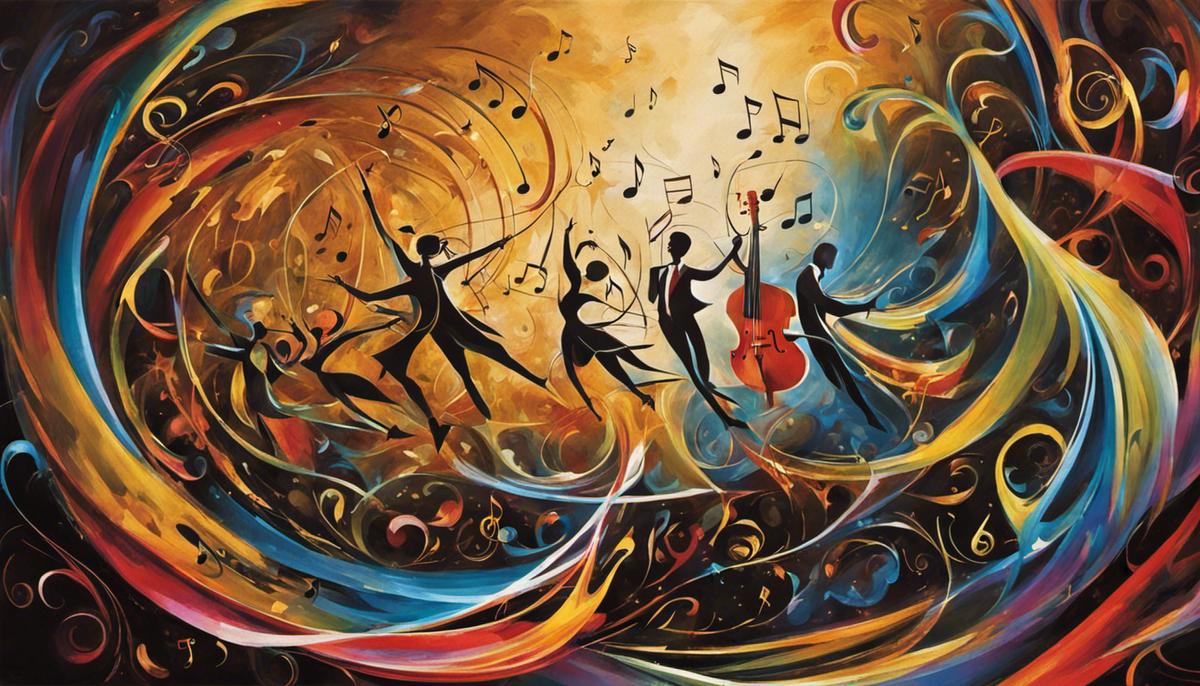
Techniques to Overcome the Challenges
Navigating the Labyrinth: Techniques and Tools to Master Mixing on Headphones
Mixing music on headphones creates a unique set of challenges, but by understanding these hurdles and employing intelligent techniques, music enthusiasts and audio engineers can ultimately achieve a fair and accurate mix, despite the limitations of headphones.
One significant obstacle often arises from the headphones’ limited ability to reproduce a soundstage, a phenomenon that is typically addressed by the utilization of advanced surround sound headphones. These headphones can provide a more immersive audio environment, mimicking the experience of multi-directional speakers, and thus are instrumental in creating a convincing soundstage.
Meanwhile, headphone mixes can sound narrower than speaker mixes due to their tendency to lack ‘crossfeed’. Crossfeed mirrors the natural phenomenon that occurs when listening through two speakers — both ears hear each speaker. This natural blending doesn’t happen with headphones, which can lead to an exaggerated stereo effect with both hard left and hard right pans. ‘Crossfeed’ plugins can be employed to enhance this experience, bridging the gap between the left and right channels and creating a more ‘in-room’ blend, thus mimicking the natural stereo spread.
When it comes to the individual perception and headphone preferences influencing the mixing process, the key to overcoming this lies within the informed selection and use of reference tracks. By selecting a well-mixed piece that encapsulates the desired sound and frequently referencing it during the mixing process, one can achieve a fair mix that should translate well across various systems.
Equally vital in this endeavor of mixing music on headphones is the understanding and acceptance of the headphone’s limits. Given the unique distortion they often cause, especially in the lower frequency range, mastering the art of monitoring the low-end frequencies becomes utterly crucial. Various frequency spectrum analyzer plugins enable one to visually monitor the mix, ensuring it covers all desired frequencies.
Advancements in mixing and mastering technology have brought about a cornucopia of plugins and software designed to help achieve the desired mix on headphones. Convolution reverb tools, for instance, can help mimic different environments, allowing one to tailor the ‘room sound’ to their preference, thus influencing the performance of the mix. Furthermore, plugins that emulate the interaction between the ear and the room can also be enlisted to create a more realistic stereo image, granting the ability to ‘place’ sounds in the mix more effectively.
The journey of mixing music on headphones is indeed an art, steeped within the constant evolution of creativity, innovation, and technological progress. By employing the right mix of tools, knowledge, and techniques, one can navigate this labyrinth to create and experience deeply immersive, harmoniously balanced, and accurately represented musical journeys. Triumph thus lies not in the avoidance of these challenges but in the conquering of them, leading to the delivery of unprecedented musical experiences.
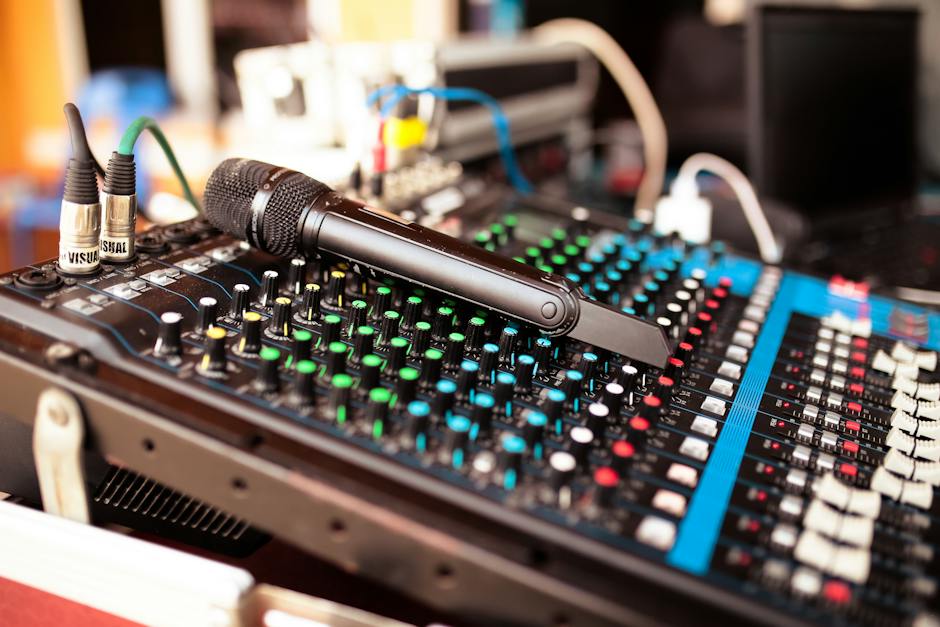
Listening Practices and Acquiring the Right Gear
When traversing the sonically diverse pathway of music, the companionship of your trusty headphones can oft feel as intimate as a shared crescendo between lovers, echoing a rhythmic dance between technology and emotion. Yet, paradoxically, these seemingly boundless seas of sound within our headphones pose unique challenges to mixing and mastering engineers, creating a milieu quite unlike the conventional stereo mediums.
One such challenge presents itself within the realm of headphone mixing, where confining the grand theatre of music inside two channels incites a domino effect on the perception of spatial elements. The missing “crossfeed” phenomenon – the transmission of sound from one stereo channel to the other, inherent in speaker listening – can result in an exaggerated stereo field, painting an unrealistic musical panorama. It’s like trying to recreate the grand expanse of the Saharan dunes in a shoebox – possible, yet far from perfect.
However, with this evolving landscape of musical ventures, it’s crucial to embrace individuality. Each listener’s perception and preferences shape their musical journey, simultaneously co-scripting the narrative of music mixing on headphones. An array of frequencies transpiring from these devices reveals a unique perspective on a composition, demanding innovation and artistic flair from the mixing engineer.
In this realm full of challenges and limitations, triumph and innovation often exist side by side. The choice of headphones, once contemplated as a mere accessory, now holds the potential to revolutionize the sonic experience offered to the listener.
Unveiling this potential calls for ingenious solutions, like adopting surround sound headphones. This technology mimics a multitude of virtual speakers positioned around the listener, enhancing the depth and scale of the sonic landscape, breathing a second life into the soundstage, previously limited by conventional stereo headphones.
Moreover, the use of crossfeed plugins, adeptly designed to emulate the speaker crossfeed in a headphone environment, adds an element of genuineness to the mix. Coupled with meticulously curated reference tracks, these plugins offer an intriguing contrast, highlighting areas for improvement and guiding toward achieving a fair, balanced mix.
Yet, like an unwavering maelstrom, the challenges do not cease. The prowling limitations of headphones, specifically in presenting an authentic representation of low-end frequencies, can mar the auditory experience. However, resourcefulness finds a way through. Tools like frequency spectrum analyzer plugins ensure comprehensive frequency coverage, offering an extra layer of insurance against frequency dips or peaks.
The world of music production rejoices in the face of advancements like convolution reverb tools and plugins, emulating the complex interaction between the ear and room. These tools enliven the music, making the mix more believable and immersive, narrowing the gap between headphone and speaker listening.
Indeed, the artistic and technical journey of mixing on headphones can seem like a daunting odyssey. Each hiccup in the path, however, provides a unique opportunity to shape and reshape the panorama of sound, always keeping the listener at the heart of the process.
Overcoming these obstacles is a testament to the relentless spirit of music lovers and creators. It is a celebration of the joy of persistently delivering immersive, and balanced musical experiences—crafted inside the humble dimensions of headphones, yet resonating amidst the grand expanse of the human spirit—imbuing each note with the dynamic nuances of our shared passion for music. And in doing so, together, we keep the beautiful symphony of music alive and evolving, ever echoing the melody of human innovation.

The journey of mixing music on headphones is fraught with challenges, primarily to do with the complex dimensions of Soundstage and Stereo Imaging. However, these challenges can be surmounted, provided enthusiasts and hobbyists are armed with the right knowledge and tools. Implementing specific plugins, choosing headphones designed specifically for the purpose, and cultivating significant listening habits are among the strategies and techniques that could revolutionize your mixing process. By factoring these into the equation, music enthusiasts can achieve mixes of stark realism and remarkable fidelity, bridging the gap between the source of the sound and the listener. The art of creating enchanting auditory spaces lies in understanding, acknowledging, and overcoming these challenges. And as one progresses on this melodic expedition, the true essence of music and technology blending harmoniously will be realised.
Delving into the digital music universe, one will quickly encounter the necessity to comprehend the vital concept of Musical Instrument Digital Interface (MIDI) connectivity. Whether you are a seasoned professional in the music industry or an enthusiastic hobbyist, the understanding of MIDI’s inner workings and connectivity strategies is pivotal to effectively creating or editing music in today’s highly digital studio environments. This text seeks to introduce the essential foundational elements of MIDI connectivity, such as MIDI data flow mechanisms, types of MIDI cables, as well as the crucial role of MIDI interfaces.
Understanding MIDI Connectivity Basics
A melody drifting on the air, harmonies surging like waves on the shore, pulsating rhythms that intertwine and interlock — it’s an arcane symphony that elevates our spirit, as profound as a heartbeat yet as enigmatic as a labyrinth. Yes, we’re talking about music, not the regular symphony but the electrical interplay of sounds that engulfs the digital soundscape. Welcome, fellow music aficionado, to the intricate world of MIDI.
MIDI — Musical Instrument Digital Interface — is a universal language for synthesizers. A meeting place of art and tech, a synergy of human creativity and artificial intelligence, it allows diverse electronic musical instruments, computers and other related devices to connect and communicate, transcending the barriers of traditional music-making in the process.
1. MIDI Cables: Bridge between Instruments
Predominantly, the cables, or more specifically five-pin DIN cables, play a vital role in this connectivity. It is these humble conduits that serve as the essential pathways, transmitting MIDI data from a controller to a receiving device, driving the symphony into the digital realm.
2. MIDI Out, In, and Thru: Trio Facilitating Connectivity
When it comes to MIDI instruments, the holy trinity of MIDI Out, MIDI In, and MIDI Thru are elements that warrant meticulous understanding. “MIDI Out” port sends MIDI data from your device, while “MIDI In” receives the data. The unsung hero, however, is the “MIDI Thru” port — it reproduces the data received by its “MIDI In” counterpart and sends it to other devices in the chain.
3. MIDI Channels: Channels of Creative Fusion
Each MIDI message sent contains information about the MIDI channel it belongs to, much like a train carrying the destination board. There are 16 channels in all, allowing individual data streams, and helping you to control multiple instruments simultaneously. It’s like playing an orchestra single-handedly, lending a broad canvas for the tones and tunes to interplay.
4. MIDI Controllers: Maestro of the Symphony
MIDI Controllers serve as conductors to this digital symphony. Whether keyboard-based, wind, percussion, or string-oriented, these devices generate the MIDI data to be sent through the “MIDI Out” port. You could exploit various controllers to create a myriad of sounds, steering the musical odyssey according to your whim and fancy.
5. MIDI Software: The Intelligent Assistant
The software interprets incoming MIDI data and transforms it into harmonious music. Well-engineered software packages proficiently generate sounds, letting your creativity resonate through dimensions. Editing, adding effects, layering tracks, the possibilities are limitless!
6. MIDI Interface: The Virtual Orchestra
To play a symphony, one doesn’t need to juggle over multiple instruments. A MIDI interface can connect multiple MIDI devices to your computer, opening doorways to seamless composition, editing, and archiving of your music.
These essential elements, harmoniously functioning together, empower MIDI to transcend the barriers of traditional music-making. With MIDI connectivity, one can navigate uncharted territories of melodies, witness a conductor-less symphony of silence and sounds, and encounter music from a truly captivating vantage point — straight from the heart of the digital realm. The keys are at your fingertips; let the symphony of connectivity play on.
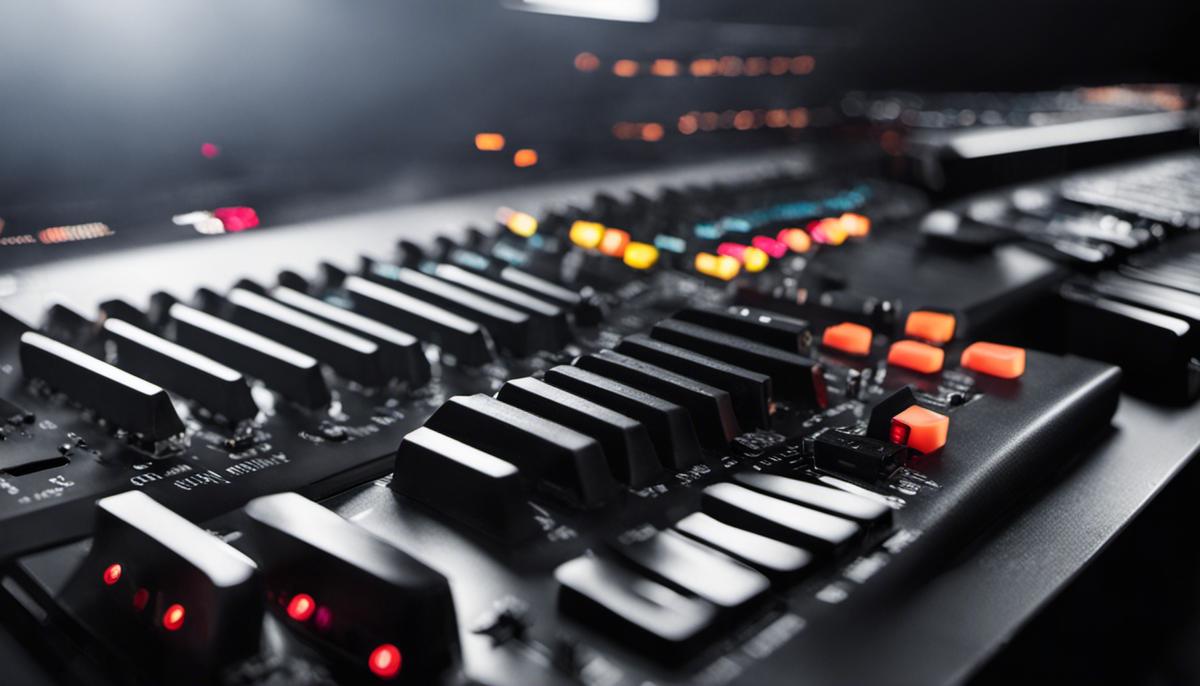
Common MIDI Connectivity Issues
Piercing the Fabric of Melody: Troubleshooting Common MIDI Connectivity Issues in the Studio
The universal language of music unites us all, permeating our lives with a delicious symphony of soundscapes that transcend traditional borders and barriers. Parsing notes, patterns, and rhythms are made easier with the advent of the Musical Instrument Digital Interface (MIDI) but simultaneously, the technology introduces specific challenges in connectivity. Identifying the most common MIDI connectivity problems, you will transform these issues from troublous orchestrations to tuneful phrases of harmonic triumph.
Endeavor first into the dominion of incorrect or inconsistent data transmission. Just as a conductor guides an orchestra, your MIDI controller is directing the digital symphony of sounds across your workstation. But if your MIDI data is out of sync or not transmitting at all, the musical magic can falter. To resolve such cacophonies, soft-resetting equipment, or reinstate original factory settings, can restore rhythmic balance, as can verifying the compatibility of software and drivers with updated versions. Similarly, establishing that the MIDI cables aren’t causing dischord by testing with multiple cables can silence any connectivity blues.
Next, consider MIDI latency, the delay between hitting a note and hearing it. Nothing stings more sharply as a false note in your composition induced by lag. Such ghost notes may often point to issues in your MIDI Interface setup. Rectifying these involves optimizing buffer size and checking if your MIDI interface drivers are up-to-date. Always remember, operating systems, controller drivers, and DAW software should dance in elegant harmony.
Let us, too, consider the issue of conflicting MIDI signals which can disrupt the flow of your symphony. Imagine multiple drummers in an orchestra, each pound to a beat of their own, reigning chaos over rhythm. Similarly, multiple MIDI signals sent at once can cause disarray in your mix and result in problematic sonics. A field guide to this wilderness involves meticulously tracking your signal path, ensuring no devices are inadvertently transmitting conflicting MIDI data. Control here is key, just as you would control the tempo of a live performance.
Lastl, the complexity of controlling multiple instruments is a classic obstacle in MIDI connectivity. Like adeptly playing different instruments, routing various MIDI channels requires finesse. Mistakes here will lead to eerie silences or unexpected sounds, the digital equivalent of a string breaking on stage. Successfully managing these channels to coerce harmony involves careful review of your MIDI routing matrix and the individual channel assignments.
From data transmission issues to latency, conflicting signals, and handling multiple instruments – engaging in the melodic dance of MIDI can sometimes feel akin to conducting an unruly orchestra. However, identifying these common MIDI connectivity problems, your studio will become an electronic symphony hall reverberating with notes in perfect harmony. From this cacophonous world, you have the ability to orchestrate a symphony, piercing the fabric of the silence, birthing a melody from digital chaos. Welcome to your digital mastery of music.
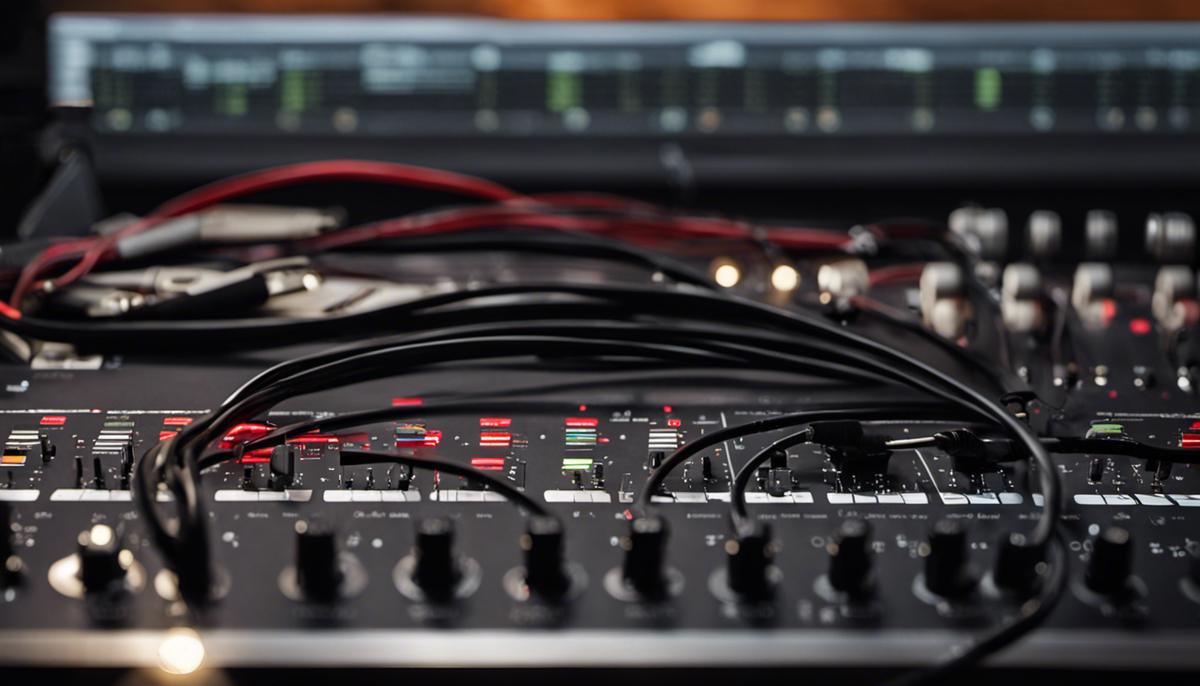
Troubleshooting Techniques for MIDI Connectivity
The race against the beat, the eclectic crescendo of harmony, and the symphony of a well-orchestrated studio can sometimes be hindered by one tiny hitch – MIDI connectivity issues. When the heart-racing wonder of your masterpiece is on the line, knowing how to troubleshoot these hiccups can do more than just save the day; they can save your music.
When it can feel like your creative gush is stunted by a wall of technical jargon and a maze of cables, start with the basics. The silent protagonist of the digital symphony, data transmission, takes center stage. Averaging the digital waves of MIDI connectivity might seem a little overwhelming, but imagine an incorrectly transmitted MIDI data string as a chord with one unfortunate stray note. Detangling this discord means identifying inconsistent data transmission. This could range from garbled software readings to missing instructions. It is the musical equivalent of playing a melody with a couple of notes missing!
While the rhythm of connectivity pulses away, sometimes, all it takes for clarity is a moment of respite. Soft resetting your MIDI device or restoring factory settings can often rectify minor errors, much like a maestro regaining his tempo.
A studio isn’t just an assemblage of devices. It’s a harmonized ecosystem. Just like every music genre has its unique rhythm, every hardware and software has specifications and requirements. Ensuring compatibility among various elements in your ensemble is as important as making sure the cello doesn’t drown out the flute! Update and verify compatibility of your drivers and software periodically to maintain a tuneful synergy.
Your music is the language, and MIDI cables–the vocal cords. Corroded connectors and faulty cables may cause data transmission losses, leading to silent notes in your masterpiece. Regular testing and maintenance can keep these essential conduits of your symphony in optimal working condition.
Latency issues are a dreaded enemy of any artist. It’s like hitting a note and hearing it echo back seconds later. Investigate for potential latency issues which can affect note timing and stifle musical magic you’re trying to create. Optimize buffer size and adopt updates for your MIDI interface drivers to keep this arch nemesis at bay.
But what happens when numerous instruments, countless tracks, and scores of effects converge into a potential chaos? Conflicting MIDI signals can drown out the harmony you’ve been striving for. Addressing this means being the meticulous conductor, tracking the signal path and managing conflicting MIDI data transmission.
Having a bird’s eye view of your studio setup keeps you in control. Carefully route various MIDI channels to prevent conflicting data from distorting your masterpiece. Review the MIDI routing matrix and individual channel assignments frequently to ensure every element dances in perfect rhythm.
Music, in its essence, isn’t just about melody and rhythm – it’s also about order and organization that brings a symphony to life. Just as you would fine-tune your instruments, fine-tuning your MIDI connectivity can make your studio setup sing without any hiccups. The art of troubleshooting MIDI issues lies in grappling with the cracks, striking the perfect balance, and making your music resonate louder and clearer than ever before. And remember, in music and in troubleshooting, sometimes it’s the tiny adjustments that lead to the most harmonious outcomes.
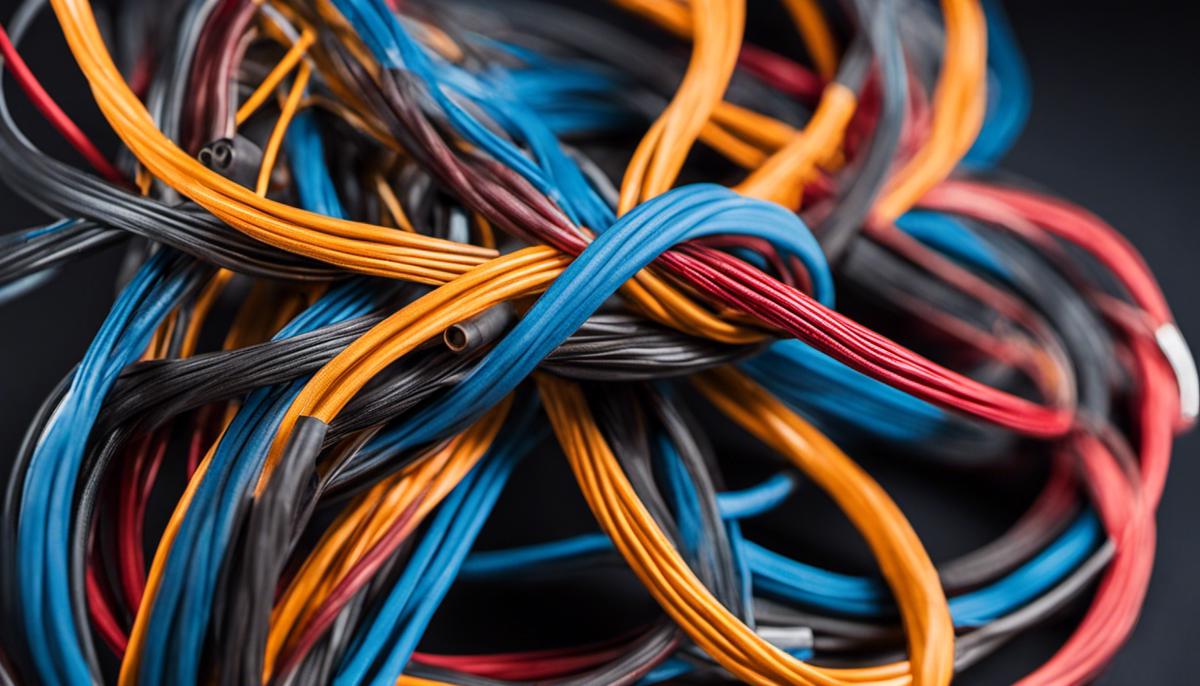
Armed with the knowledge about MIDI connectivity basics, the ability to recognize common issues, and the skills to apply appropriate troubleshooting techniques, you are well-equipped to navigate any MIDI-related challenges that may occur in the studio. Remember, mastering these concepts not only solves immediate problems but also enhances your overall competence and creativity as a digital music artist. So whenever you find yourself facing a MIDI mystery in the studio, remember to stay calm, investigate carefully, and apply the problem-solving strategies detailed in this guide.
Page 4 of 12 « First ... « 2 3 4 5 6 » ... Last »


















